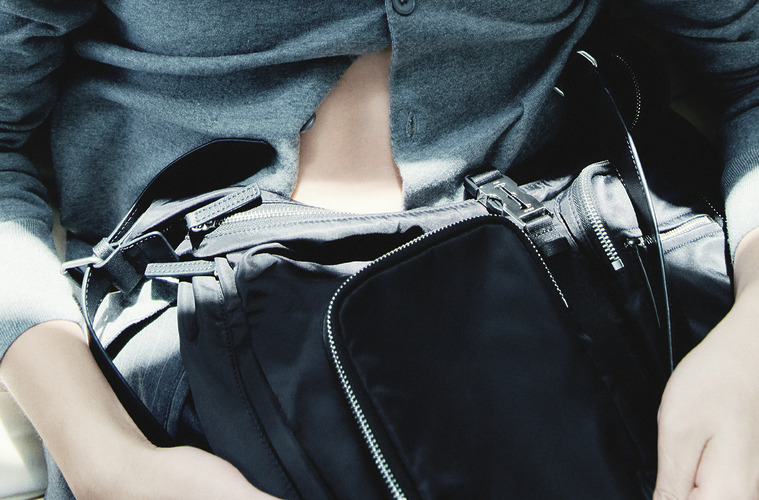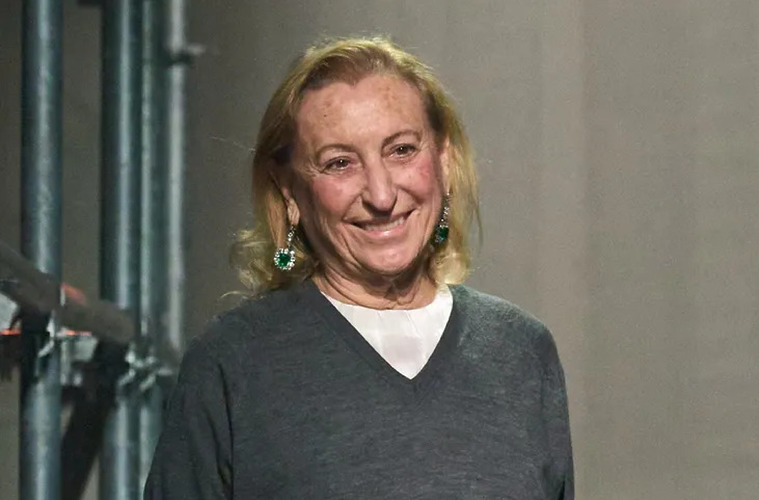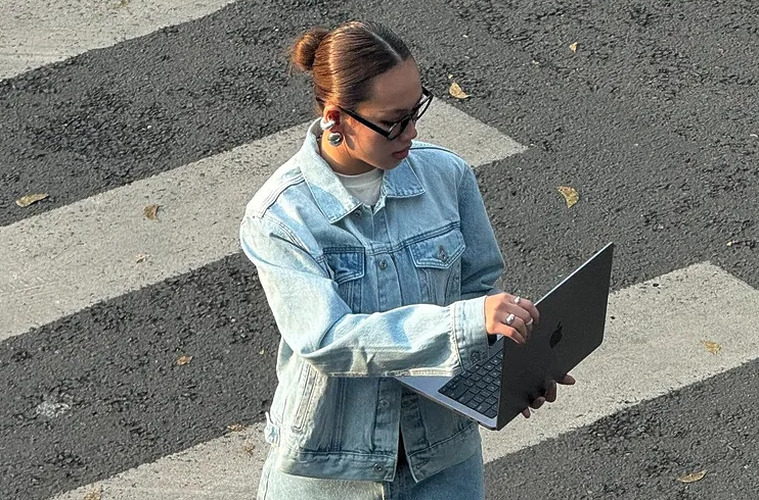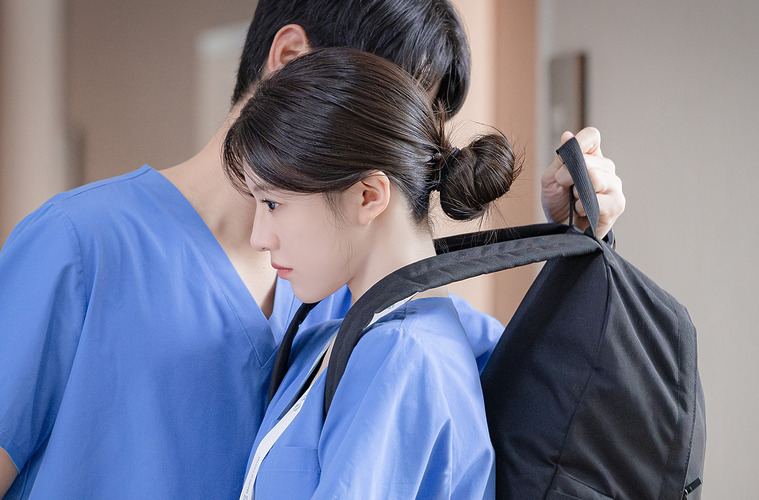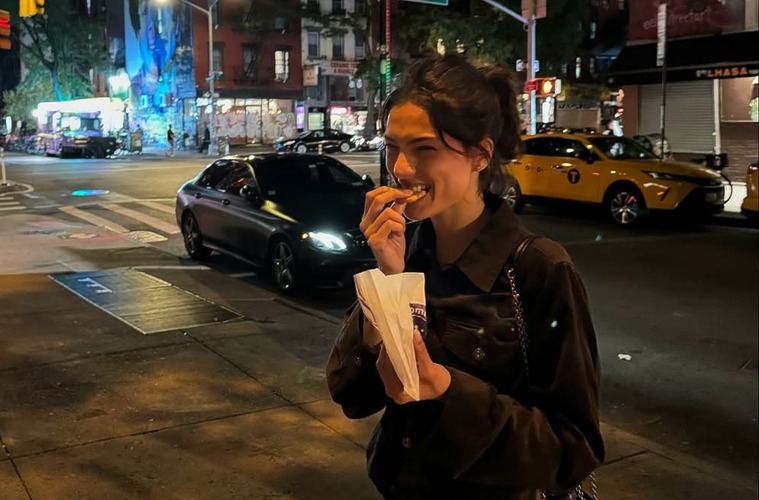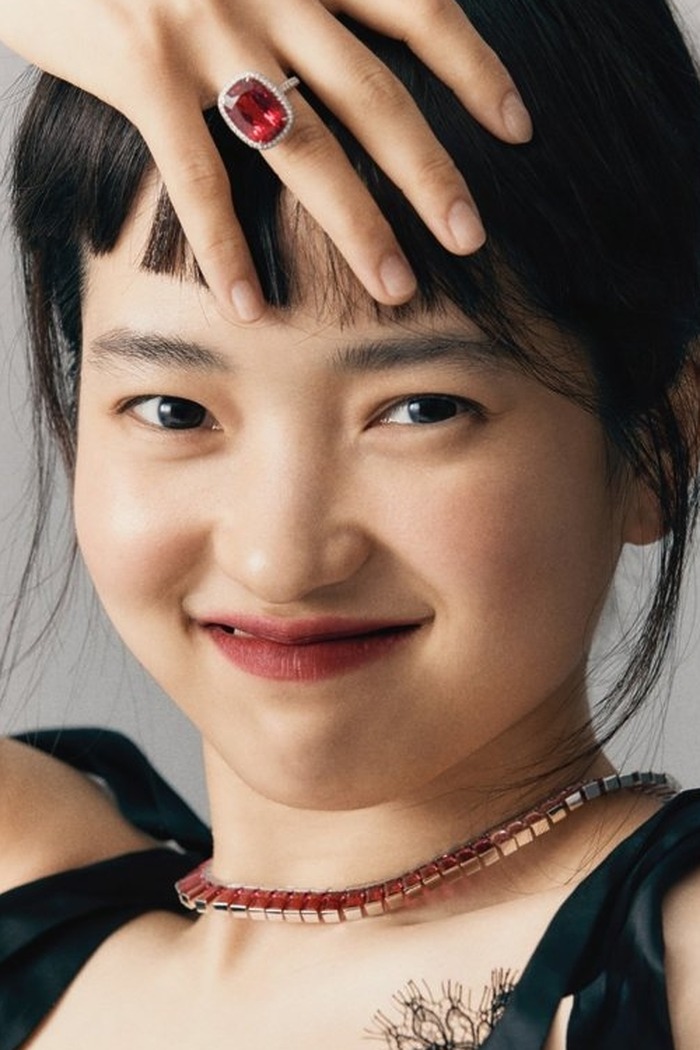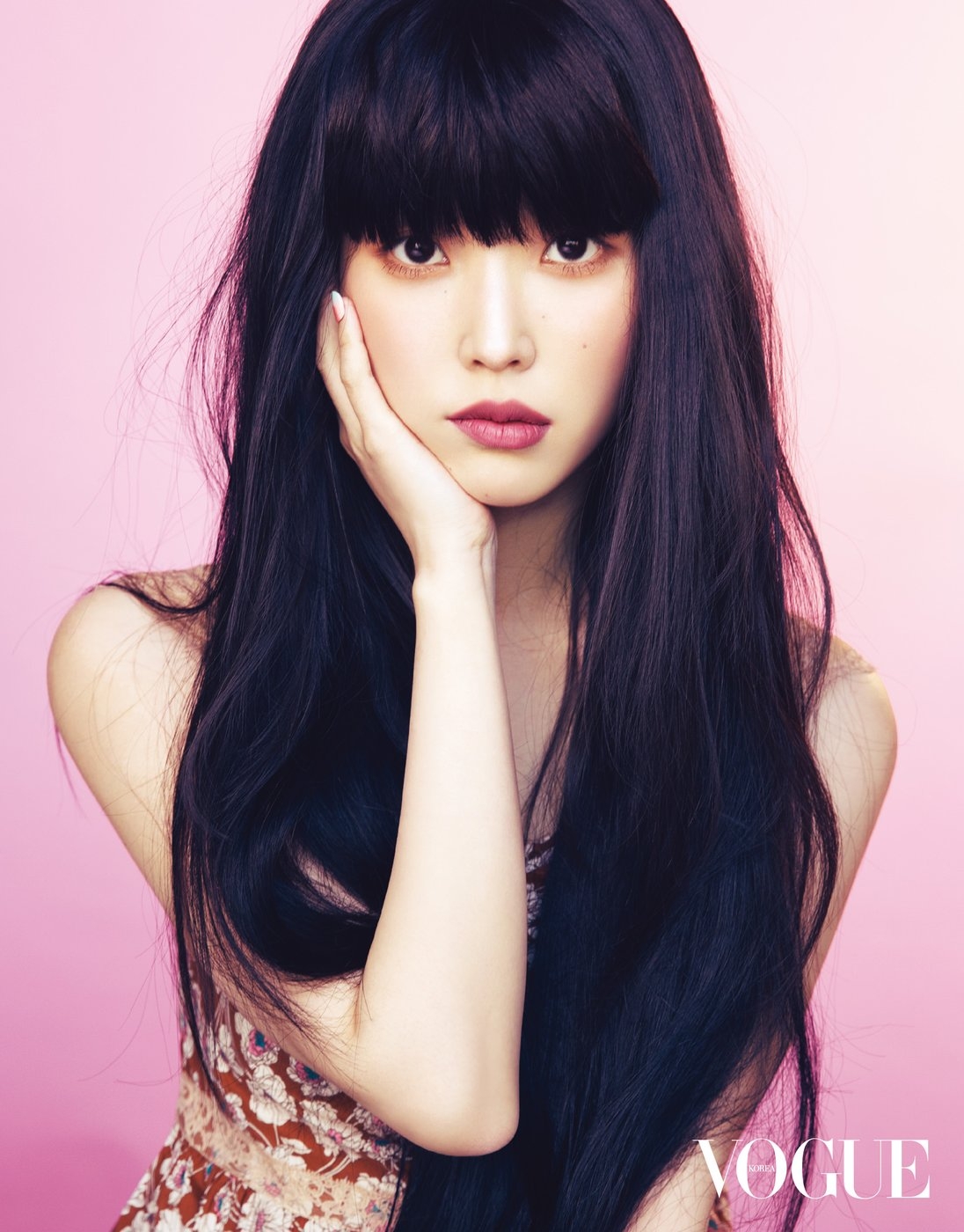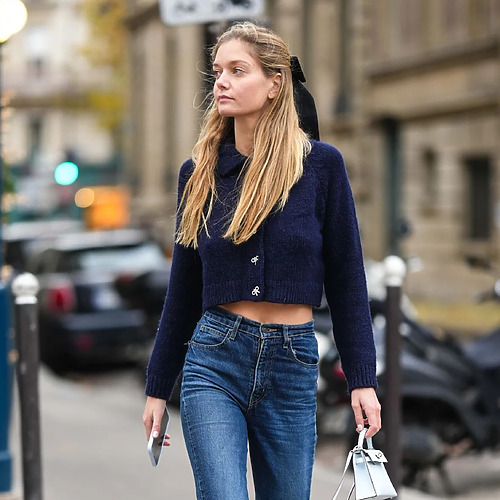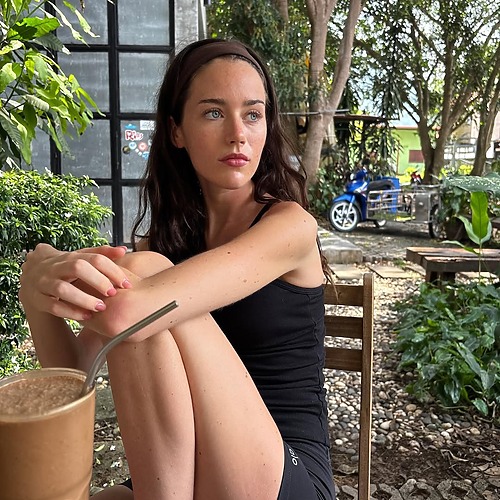수지 멘키스가 품평한 2015 S/S 밀라노 패션 위크 1
‘보그 인터내셔널 에디터’ 수지 멘키스는 세계에서 가장 유명한 패션 저널리스트다.
<인터내셔널 헤럴드 트리뷴>(현재 <인터내셔널 뉴욕 타임즈>로 이름이 교체됐다)에서 25년 간 패션 비평을
담당한 그녀는 현재 세계 각국의 ‘보그닷컴’을 위해 독점 취재 및 기사를 쓴다.
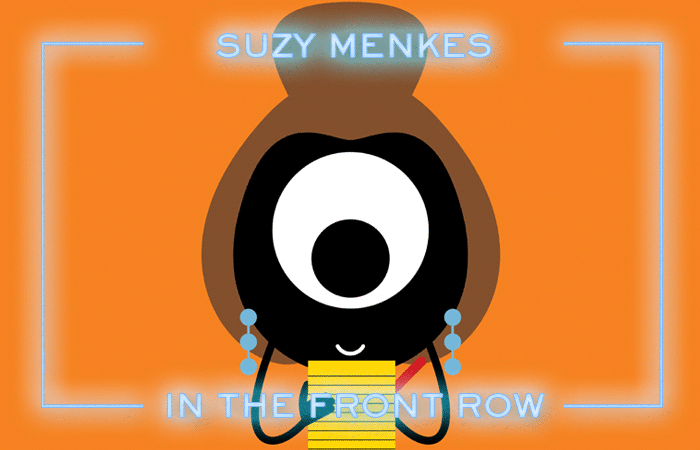
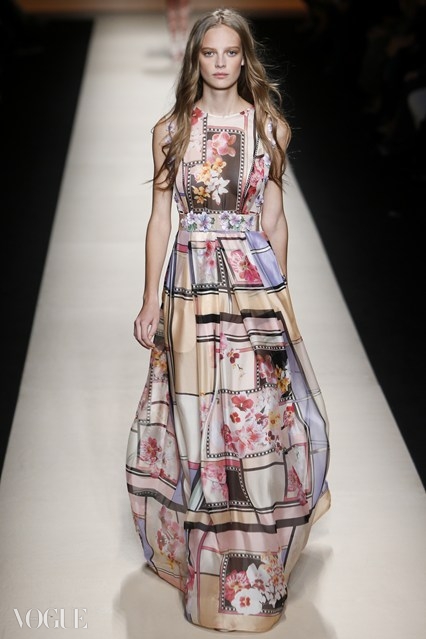
Alberta Ferretti
알베르타 페레티 쇼는 부서질 듯 연약한 패션계의 공주 같았다. 2015년 봄, 여름 시즌을 위한 그녀의 섬세한 작품엔 (너무 작아서) 마치 요정의 손 끝에서 탄생한 듯한 주름이 잡힌 스킨 컬러의 쉬폰이 눈에 띄었다. 꽃들은 무리 지어 등장했고 꽃잎들은 드레스 위에 펼쳐졌다. 그녀의 손을 거치면 데님조차 실크처럼 부드러워 보인다. 다시 말해, 페레티 쇼의 흥미로운 점은 레드 카펫의 화려함이 섬세한 캐주얼로 바뀌었다는 것.
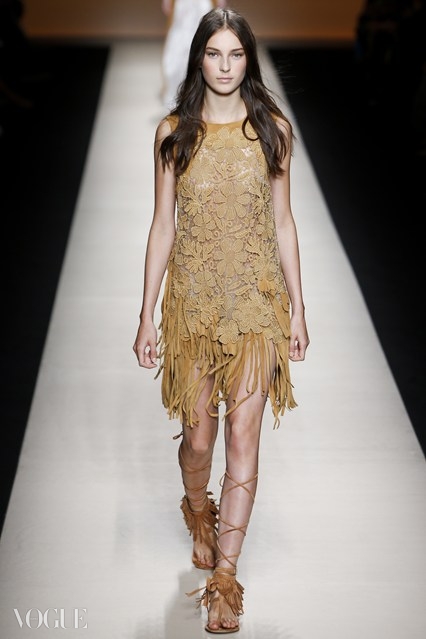
그녀가 선보인 새로운 룩에는 가벼운 쉬폰 팬츠나 70년대에 보았던 카우보이 프린지가 등장했다. 보디라인을 살린 의상들은 서서히 사라졌다. 알베르타 페레티에겐 저속한 면이 전혀 없다. 그래서 지난 날 동안 그녀의 레드 카펫 위를 걸어 나온 의상들은 늘 점잖고 고상했다. 그러나 이번 시즌, 데님을 커팅한 아이디어는 그녀가 보여주지 않았던 새로운 종류의 스포티 캐주얼을 보여주었다.드레스도 마찬가지. 가슴 쪽을 장식한 꽃들이 비밀의 정원을 형성했지만, 지나치게 우거지거나 관능적인 분위기는 없었다.
페레티는 앞으로 나아가는 것이 중요하다. 그녀는 이번에도 우아하게 해냈다. 이제 고급 취향의 고객들이 그녀의 가이드를 따라 멋진 옷차림에 대한 부드러운 접근방식을 받아들이길 기대해본다.
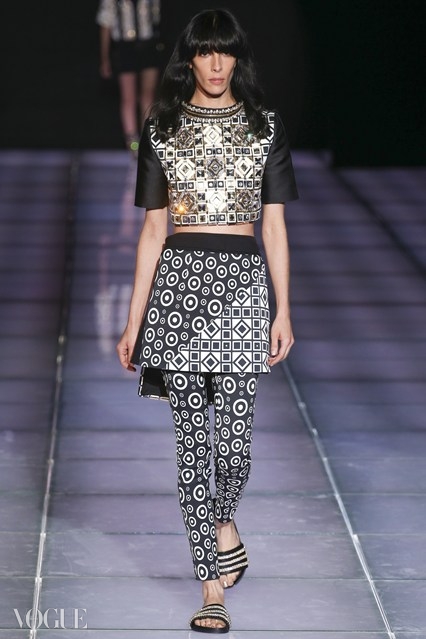
Fausto Puglisi
‘줄리어스 시저’가 클럽에 갔다면 분명 이런 모습이었을 것이다! : 반짝이는 서양 장기판 바닥을 쿵쿵거리며 걷는 글래디에이터 샌들, 헤르쿨라네움(이탈리아 나폴리 만 근처에 있던 옛 도시로 베수비어스 화산 폭발로 폼페이와 함께 매몰되었다)에서 출토된 모자이크 같은 체크 무늬 가운. 그리고 언제나 질서 정연한 기하학 패턴. ‘파우스토 푸글리시’가 다프트 펑크의 폭발적인 음악에 맞춰 선보인 컬렉션은 그래픽하고, 극적이고, 간결했다.
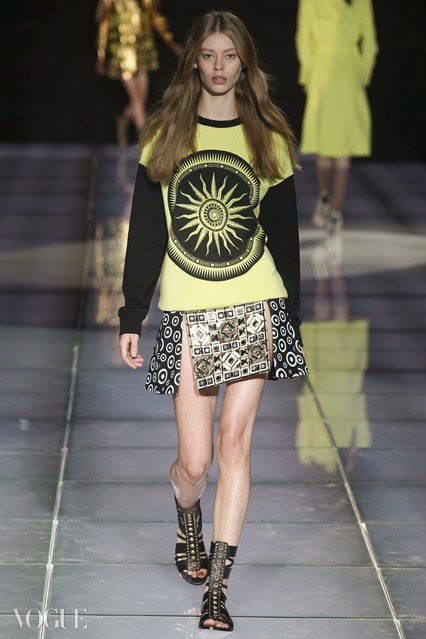
할리우드에서 일했기 때문일까. 그는 패션에 대해 영화적인 비전을 갖고 있다. 밑단이 넓게 퍼지는 코넷(작은 트렘펫 같은 악기)처럼 빳빳한 스커트나 오렌지와 라임처럼 날카로운 컬러로 제작된 테일러드 의상은 모던한 영화 세트의 일부처럼 보였다. ‘스타워즈와 바바렐라(제인 폰다 주연의 영화)의 만남’이라는 아이디어와 스탠리 큐브릭의 <2001 스페이스 오디세이>를 언급하기도 했다.
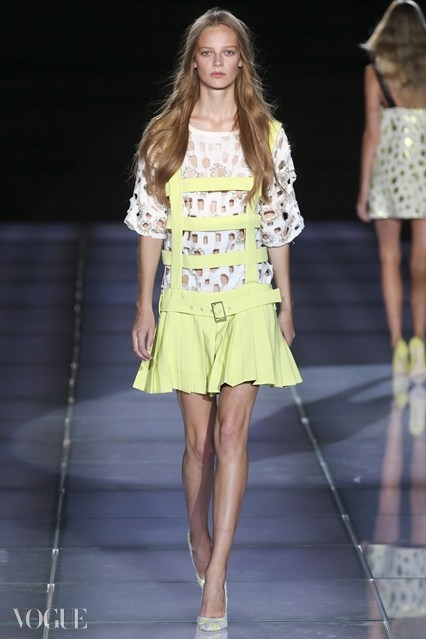
또한 60년대의 패션 마에스트로, 앙드레 쿠레쥬, 루디 게른라이히도 거론했다. 하지만 파우스토가 흥미로운 점은 직접 참고했던 레퍼런스들이 모두 고대 로마를 직접 참고했던 것들임에도 디자인이 철저히 현대적이라는 사실!
기하학적 패턴과 반짝이는 진주빛 표면은 분명 컴퓨터와 디지털화된 세계에서만 만들어낼 수 있을 것. 종종 그가 젊은 지아니 베르사체와 비교되지만, 베르사체는 디지털 이전 세대 아닌가? 파우스토는 기꺼이 자신의 레퍼런스를 인정할 것. 그러나 단언컨대, 그 결과물은 폭발적일 정도로 현대적이었다.
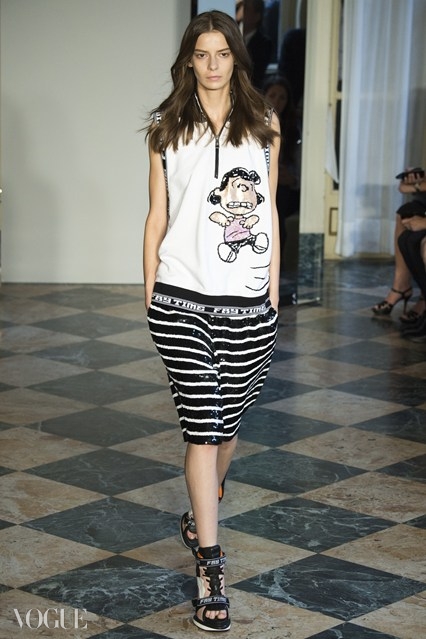
Fay
스트리트 웨어가 패션이 된 건 전혀 새로운 일이 아니다. 큼직한 톱, 그래픽 슬로건, 기하학적 실루엣으로 스포티한 의상을 만드는 건 21세기 스타일의 특징. 그래서 ‘토즈 제국’의 캐주얼 브랜드’페이’는 탱크 톱 위의 ‘Fay Time’ 택, 스웨터의 솔기, 혹은 커다란 백팩 등으로 스포츠웨어를 역동적으로 만들어 이미지 변신을 꾀했다. 찰스 슐츠의 ‘피너츠’ 만화 캐릭터, 말괄량이 걸 ‘루시’가 나머지 공간을 채웠다.
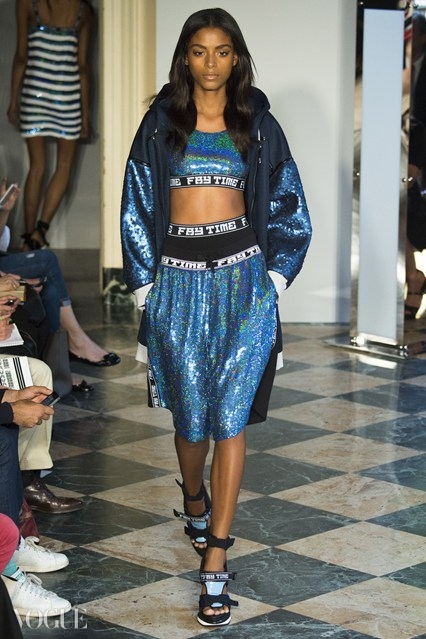
으레 래퍼를 떠올리게 하는 스트리트 룩의 공격적인 무드는 베이비 핑크 컬러와 젊고 통통 튀는 재미있는 무드를 더해 한층 친근해졌다. 고급스러운 패브릭과 역사적인 비전으로 유명한 디자이너 ‘토마소 아퀼라노(Tommaso Aquilano)’와 ‘로베르토 리몬디(Roberto Rimondi)’ 는 인터넷 세상과 페이를 연결하는 미션을 수행했다. 그들은 테크노 패브릭을 사용했는데, 이태리 장인이 까다로운 공정이 깃을 통해 만든 고급스러운 원단을 세련된 스트릿 웨어로 선보인 것이다.
또 한가지, 눈에 띄는 제품은 농구화였다. 풋 웨어를 기본으로 한 회사에서 나온 디자인이라 그런지, 힐과 스트랩으로 한층 여성스러워진 농구화의 진화가 주목받았다. 밀라노 여학생 혹은 그녀의 전 세계 친구들을 위한 귀여운 액세서리가 될 것!

Stella Jean
큼직하고 스포티한 티셔츠, 나뭇잎 패턴이 그려진 블라우스, 그리고 야자수들에 둘러싸인 오두막 이미지가 프린트된 스커트를 선보인 스텔라 진은 새로운 컬렉션을 위해 다른 목적지로 향했다.
“저는 집으로 갔어요.”라고 그녀는 말했다.
이 말은 그녀가 디자이너로 데뷔한 후 처음으로 자신의 핏줄의 일부인 ‘아이티’를 참고했다는 이야기. 단순히 아이티가 수영복에 프린트된 컬러풀한 프린트로만 사용된 게 아니다. 그녀의 사명 중 하나는 UN 국제 무역 센터(ITC) ‘에티칼 패션 이니셔티브(Ethical Fashion Initiative, 윤리적 패션 계획)-개발도상국의 도덕적인 공정 거래 제조 센터들을 위해 로비를 하는 단체-‘의 전문지식을 이용해 아이티에서 만들어진 것들을 사용하는 것.
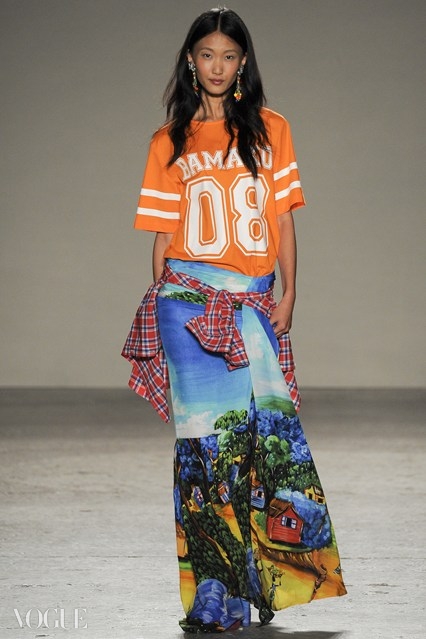
그래서 이태리에서 자란 이 디자이너는 소박한 미술(소박파(Naive Art), 전문적인 미술교육을 받지 않은 채 널리 받아들여지고 있는 미학적 원칙에서 벗어난 형식을 창조해내는 미술가들의 작품)을 통해 아이티를 담아내고 싶은 마음만큼이나 아이티 국민들을 돕는 일에도 열정적이다.
아이티에서 얻은 영감을 바탕으로 반복해서 등장하는 패턴은 모던한 스커트-풀 스커트 혹은 타이트한 스커트-위에 그려졌다. 그것은 스텔라 진이 자신의 패션 작업을 끊임없이 발전시켜왔다는 걸 보여준다.
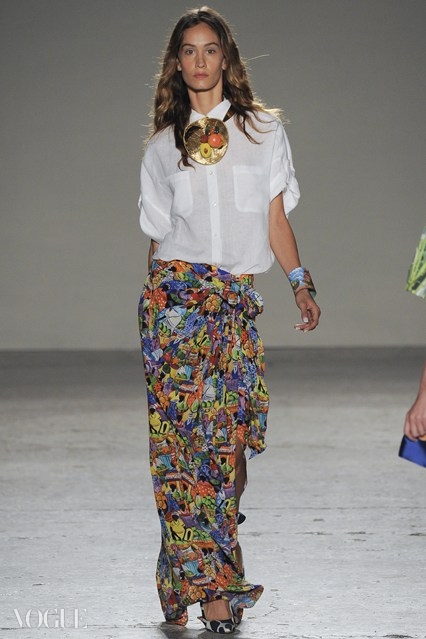
스텔라 진은 장인 정신이 담긴 주얼리-뿔 팔찌, 메탈, 심지어 파피에 마쉐(Papier Mache, 펄프에 아교를 섞어 만든 종이로 물기가 있을 때는 무르지만 마르고 나면 아주 단단해진다)로 만든 장식-도 선보였다.
‘ITC 프로젝트’를 이끌고 있는 ‘시모네 치프리아니(Simone Cipriani)’는 이번 컬렉션에 참석해 윤리적 패션 계획들은 빠르게 진행되고 있으며, 가나에 전용 공장도 건설 중이라고 알렸다. 스텔라 진의 쇼가 증명하듯이 우리 모두는 아이티 국민을 포함한 수공예 전문가들에게 작은 힘을 실어주게 된 것을 기뻐하며 패션을 즐길 수 있을 것이다.
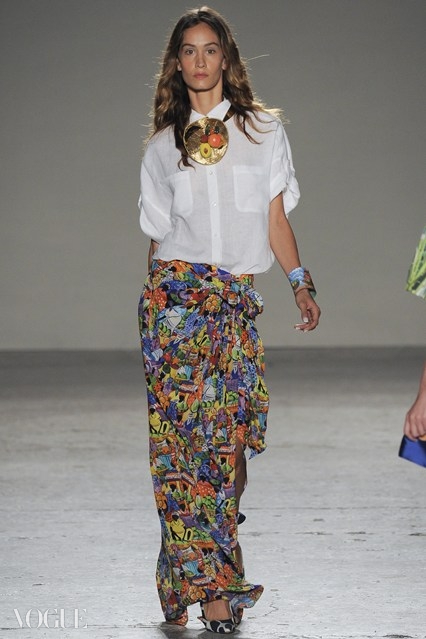
Gucci
밀라노 시즌 개막 날 열린 쇼가 활기 차 보인 건, 파이톤 소재로 몸을 감싼 '케이트 모스’와 함께 프런트 로에 앉아 있던 구찌의 승마 대사인 ‘샬롯 카시라기’ 때문이었을까? ‘크레이지 걸’이 배경음악으로 깔렸다. 모델들은 먼저 70년대 느낌이 나는 스웨이드 소재의 옷을 입었고 ‘글리터 걸치(Glitter Gulch, 라스베이거스를 대표하는 화려한 거리)’의 화려한 반짝임과 짝을 이룬 데님, 그리고 여우 털에서 염소 털까지 다양한 모피 패치워크를 입었다.
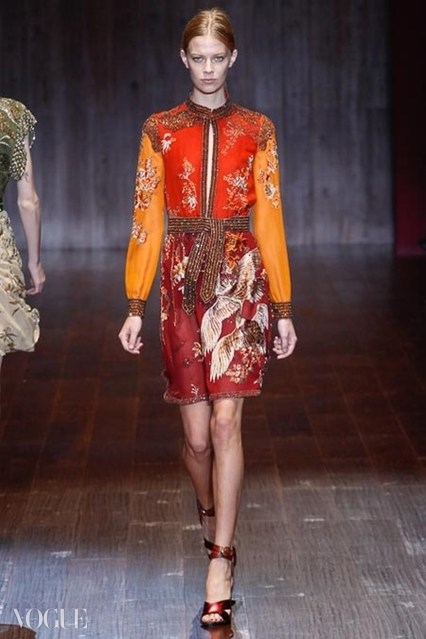
“그리고 아시아가 있어요!” 라고 무대 뒤에서 자신이 입은 실크 톱의 꽃무늬 패턴을 가리키며 ‘프리다 지아니니’가 말했다. 아마도 쇼를 보러 온 중국 여배우 ‘양미(Yang Mi)’를 의식했기 때문일 것. 혹은 구찌 그룹을 이끌고 있는 ‘프랑소와-앙리 피노(Francois-Henri Pinault)’를 의식했을 수도. (프랑소와-앙리 피노는 중국에서의 판매전략이 왜 미국이나 유럽과 다른지 얘기했었다.)
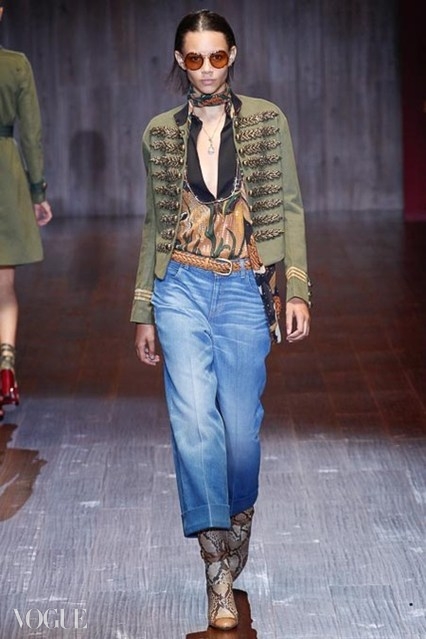
이렇듯, 제품에 초점을 맞춘 듯 보이는 구찌의 2015년 봄, 여름 시즌은 지루한 구석도 있었지만 대부분은 다양한 무드가 잘 섞여 있었다. 심플한 테일러드 블라우스는 화려한 히피 글래머를 차분하게 잡아 주었고, 중국 꽃이나 일본 두루미가 프린트 된 귀여운 드레스들은 매끄럽게 이브닝 웨어 속으로 녹아 들었다. 프리다가 좋아하는 친근한 블랙은 하나도 볼 수 없었는데, 그래서인지 이브닝 웨어들은 레드카펫 느낌이 ‘덜’ 났고 좀 더 실용적으로 느껴졌다.
이번 시즌이 신선해 보였던 건, 구찌의 핵심인 ‘캐주얼 럭셔리’였다. 액세서리도 마찬가지였다. 허리에 두 번 두른 벨트, 70년대 스타일의 백, 그리고 금장 해군 단추를 단 크롭트 퀼롯(치마 바지)이 그것. 밀리터리 프로깅(긴 스트랩과 나무 단추로 장식된 디테일)도 반복해서 등장해 글래머러스한 매력에 날카로움을 더해줬다.
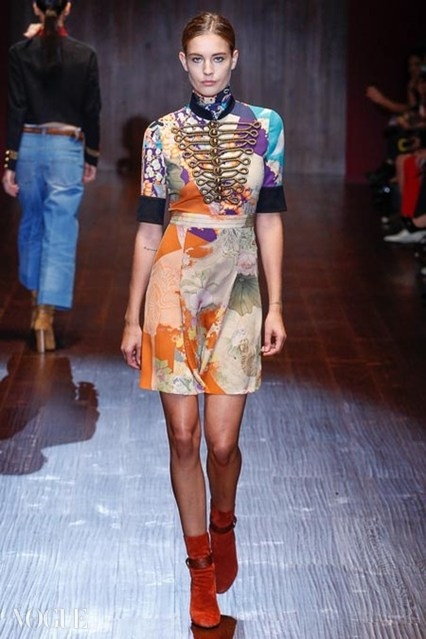
중요한 패션 스토리는 컬러. 짙은 톤의 70년대 와인, 러스트, 오렌지 컬러는 쇼의 후반부로 치달을 수록 블루와 그린 컬러로 바뀌었다. 모피의 컬러 음영은 아주 자연스럽고 은은했다.
한 가지 미스터리는 샬롯 카시라기의 관능적인 입술을 책임지고 있는 ‘뷰티 라인’을 론칭한 구찌가 왜 기존의 아이코닉한 슈즈에 더 관심을 쏟지 않았느냐는 것. 진저 컬러의 스웨이드 부츠, 오렌지 컬러의 부츠, 그린 컬러의 샌들이 있었지만 어디에서도 우리가 으레 알고 있던 ‘구찌스러운’ 아이코닉한 슈즈는 찾아볼 수 없었다.
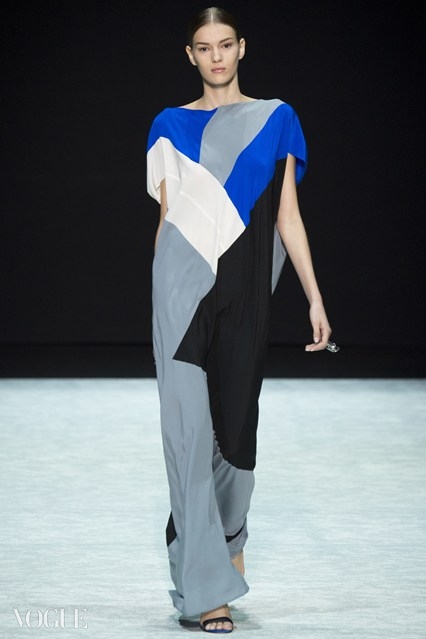
Bratis
“그를 돕는 것만이 아니에요. 우리도 돕는 겁니다. 다른 사람들이 무엇을 하고 있는지 보는 건 신선한 일이죠.” ‘Italian designer of Greek origin’ 를 수상한 그리스 출신의 이태리 디자이너, ‘안젤로스 브라티스(Angelos Bratis)’가 2015년 봄, 여름 컬렉션을 선보이는 동안 ‘조르지오 아르마니’가 말했다. 이번 쇼는 브라티스의 전도유망한 출발인 셈.
겉보기에는 편안하게 늘어진 실루엣의 드레스지만, 실제로는 정교한 작업이 오갔다. 그리스식 주름을 21세기 식 의상으로 바꾸면서 보디라인의 곡선을 깨는 밝은 컬러 블록을 더했다.
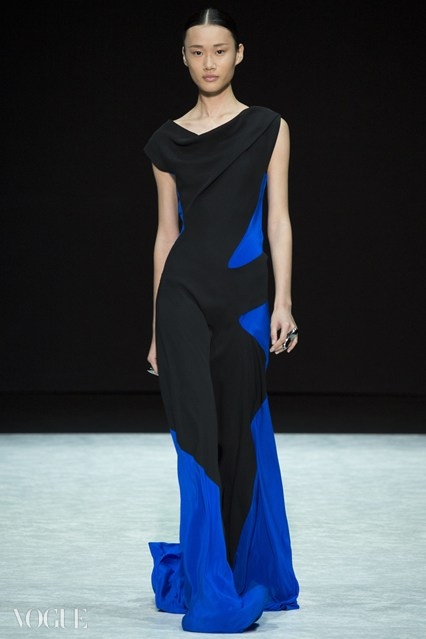
백스테이지에서 그는 “저는 미니멀리스트가 아닙니다. 순수 주의자입니다.” 라고 말했다. 그리고 아이디어 보드에 꽂혀있는 그리스 아티스트 ‘이아니스 모랄리스(Yiannis Moralis)’의 관능적이고 성적이기까지 한 곡선들로 이뤄진 작품들을 보여주었다.
관능적인 선을 참고해 드레스의 늘어진 듯한 실루엣을 만들었지만, 종종 은은한 칼라 패널을 사용해 쏟아져 내리는 실루엣을 중간에 끊어주기도 했다. 예를 들자면, 폭풍이 몰아칠 듯한 바다색에 회색과 밝은 탠 컬러를 첨가하는 식으로. 게다가 잠깐은 도트 패턴이 등장하기도 했다.
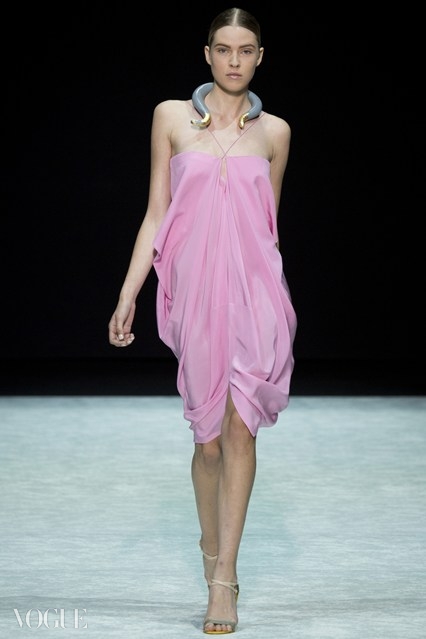
그리고 ‘마리아 마스토리(Maria Mastori)’의 대담한 주얼리-목둘레에서 뱀처럼 꿈틀대는 형태나 부적 같은 형태들-도 선보였다. 브라티스의 짧은 드레이프 드레스들은 암홀이 밑으로 내려와 오페라 무대에 서 있는 ‘클리타임네스트라(아가멤논의 아내)’처럼 보이는 긴 드레스들보다 훨씬 더 설득력 있었다.
이번 쇼는 밀라노에 ‘우아한 편안함’이라는 새로운 분위기를 조성한 좋은 쇼였다. 안젤로 브라티스는 “고마워요. 조르지오.”라고 적힌 사인을 흔들며 이번 행사를 열어준 아르마니에게 감사를 표했다.
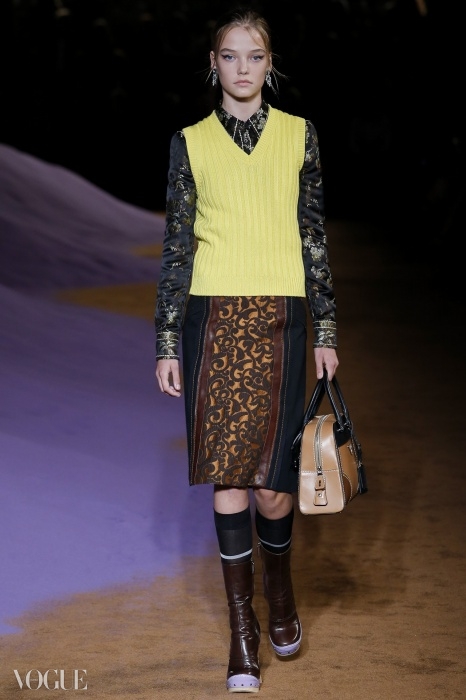
Prada
바다 소리가 황금색 플러시 카펫 너머에서 들려오는 가운데, 파도 모양의 모래 언덕 너머에선 미우치아 프라다가 연 고대의 아름다움과 현대적 심플함의 대결이 시작됐다. 한 쪽에는 낡은 다락에서 발견된 듯 보이는 브로케이드(골드와 실버 컬러의 비단) 의상들이 있었다. 풀린 실을 제외하면 수작업의 손때는 물론 고대의 아름다움을 그대로 간직한 것처럼 보였다.
감성과 이성 사이의 투쟁의 계속 되고 있는 무대의 다른 한 쪽에는 코트와 드레스들이 있었다. 드레스 위엔 자수에서 자주 쓰이는 오버스티칭이 드러났다. 브로케이드가 19세기의 웅장함을 암시한다면 이 코트들은 ‘아르테 포베라(Arte Povera, 가난한 빈약한 미술이라는 의미)’의 패션 버전처럼 보였다.
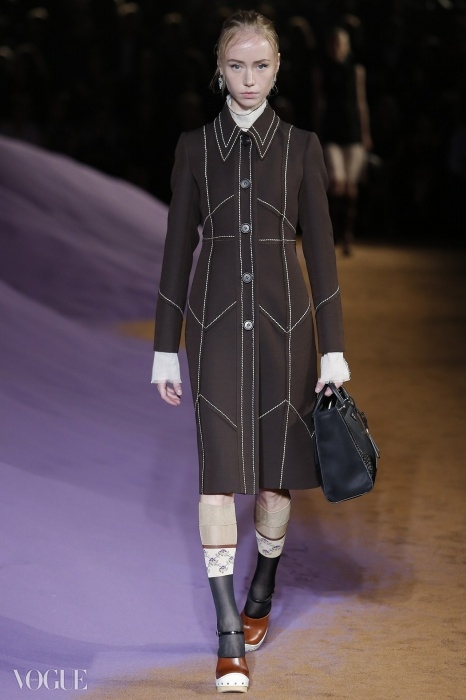
프라다의 시그너처 아이템인 물 혹은 와인(으로 비유되는)을 선택한다면 종아리 부분에 꽃 밴드가 부착된 양말과 튼튼한 힐이 달린 슈즈를 보게 될 것. 그러나 프라다에서 늘 그렇듯이-그리고 이번 쇼는 그 정신면에서 철저히 ‘프라다 다웠다’-보이는 게 전부가 아니다.
“그것은 장인들의 훌륭한 작품입니다. 샹들리에를 만드는 것과 같죠.” 백스테이지에서 미우치아 프라다가 말했다. 그녀는 자신이 어떻게 최고의 이태리 장인들에게 앤틱 브로케이드를 재 작업하고 재해석하게 했는지를 설명했다.
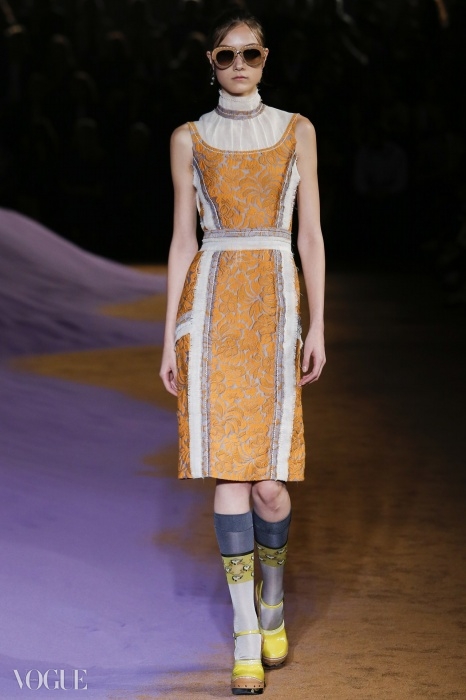
서로 다른 것을 조율하기 위한 프라다의 싸움은 지난 20년간 진행되어온 그녀의 도전 중 하나였다. 그녀가 무대 인사를 할 때 터져 나오는 환호성과 박수갈채는 사람들이 그녀의 사투를 이겨내며 꾸준히 이어오는 용기를 인정하고 존경하는지를 증명한다.
이번 컬렉션이 여느 때와 다른 점은 역사적인 아름다움이었다. 더 이상 보기 흉한 미학도 없었고 과거에 대한 향수도 없었다. 팬츠는 없었고, 심플한 스웨터와 매치된 브로케이드 스커트만 있었던 지라, 모든 의상들이 여성스러웠기 때문에 남녀의 갈등도 더 이상 없었다.
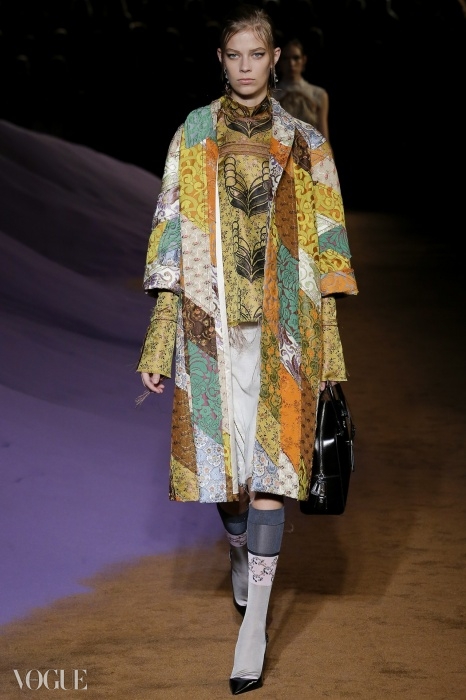
대신 그 자리에 미우치아는 과거의 기술들을 보존하며 그것을 늘, 그리고 영원히 현재까지 이어지도록 만들고픈 자신의 열망으로 가득 채웠다.
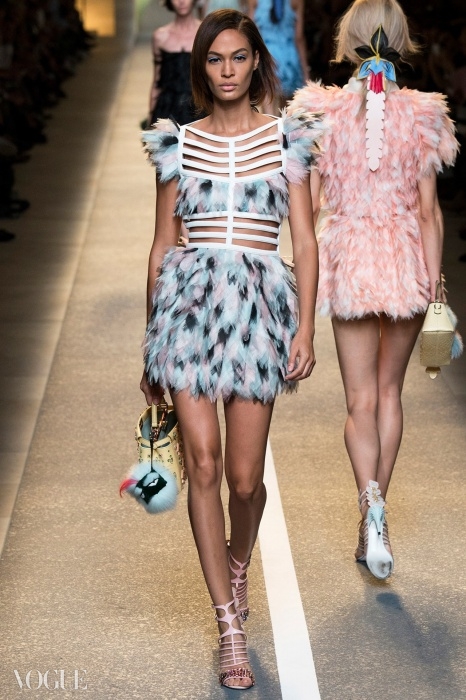
Fendi
펜디는 뜨겁다. 이번 밀라노의 봄, 여름 시즌엔 끓는점까지 들끓었다.
콜로세움 스타일의 아치 창문들이 들어선 긴 런웨이가 손님들을 맞이했다. (로마에 있는 펜디의 새 본사인 무솔리니 시대의 건물 창문도 콜로세움 스타일이다!) 실비라 벤투리니 펜디(Silvia Venturini Fendi)의 화려한 보석이 박힌 바게트 백의 반짝이는 액세서리들, 혹은 순식간에 팔려나간 작고 털이 북슬북슬한 칼리토 참이 런웨이를 장식했다. 짧은 난 꽃 프린트 드레스를 입고 쇼를 시작한 톱 모델 ‘카라 델레바인’도 칼리토 참을 백에 달고 나왔다.
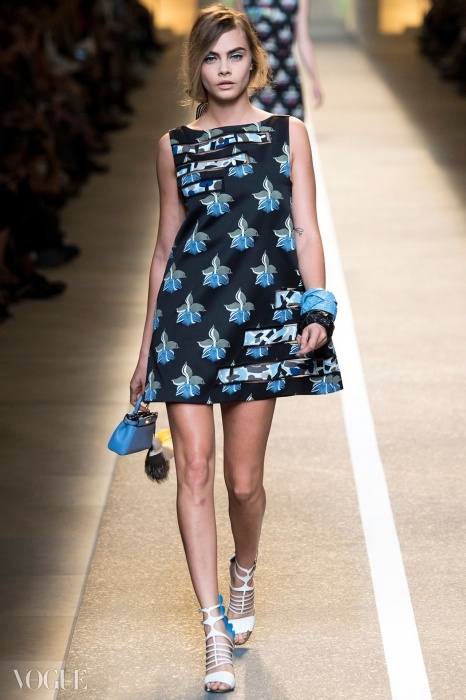
난 꽃은 라거펠트 자신이 넥타이 장식으로 착용한 새로운 펜디 로고다. 꽃은 핸드백 장식으로도 해석됐고, 모든 모델들의 목덜미에도 등장했다. 칼 라거펠트가 펜디 모피에 신선한 꽃을 푹 파묻었던 지난 시즌을 되돌아보면 꽃 브랜드의 논리를 이해할 수 있다.
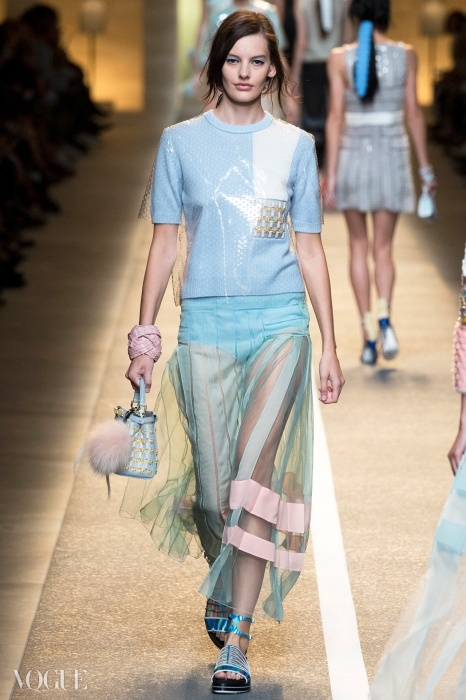
그러나 2015년 봄, 여름 쇼는 전혀 낭만적이지 않았다. 긴 쉬폰 스커트의 칼라로 사용된 옅은 블루와 핑크 컬러를 제외하고. 대부분은 딱딱하고 강직했다. 직선이 그래픽 장식으로 들어간 짧은 드레스나 자동 세차기의 커튼처럼 길게 커팅된 드레스 상체를 보라. 슈즈에도 비슷한 스트랩이 부착되어 있었지만 드레스보단 섬세했다.
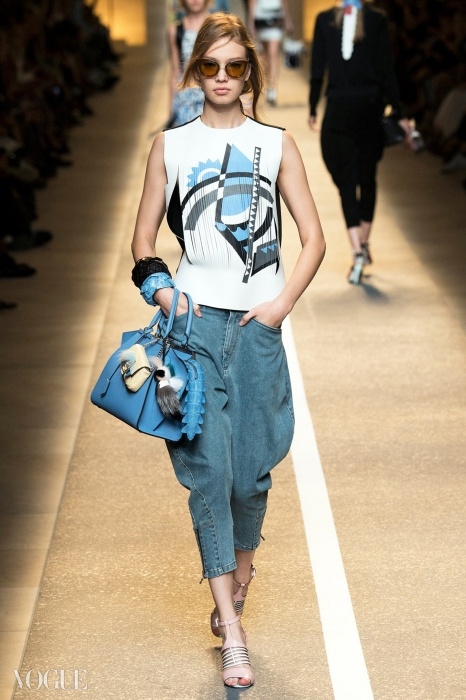
데님은 라거펠트가 보여주고자 한 기하학적인 구조의 일부였다. 기이한 승마바지 형태의 진을 위해 컴퍼스로 기하학적인 선을 그렸다. 나는 칼이 새로운 펜디 본사인 로마의 ‘팔라초 델라 시빌타 이탈리아나(Palazzo della Civiltà Italiana)’에서 영감을 얻었을 거라고 추측한다. 펜디가 나눠준 팸플릿에는 그가 아주 그래픽하게 찍은 이 건물의 사진이 실렸다. 백 액세서리들은 ‘삭스 피프스 애버뉴(Saks Fifth Avenue)’의 새 사장인 ‘메리게이 맥기(Marigay McKee)’가 증명하듯 엄청난 히트였다. 메리게이 맥기는 펜디의 회장이자 CEO인 피에트로 베카리(Pietro Beccari)에게 달려가 ‘삭스 피프스 애버뉴’에 펜디의 첫 번째 소유권을 달라고 부탁했다.
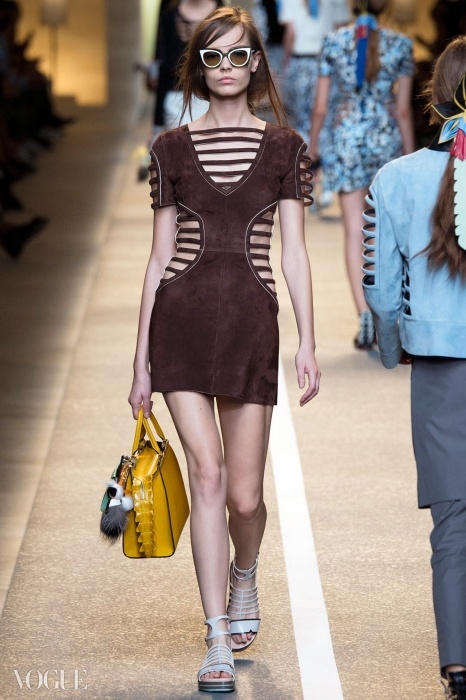
나는 피에트로에게 칼이 선보인 난 꽃이 펜디 브랜드의 일부로 계속 남을 것인지 물어봤다. 그리고 그는 이렇게 대답했다.
“적어도 앞으로 두 시즌 동안은요. 하지만 칼을 잘 아시잖아요……”
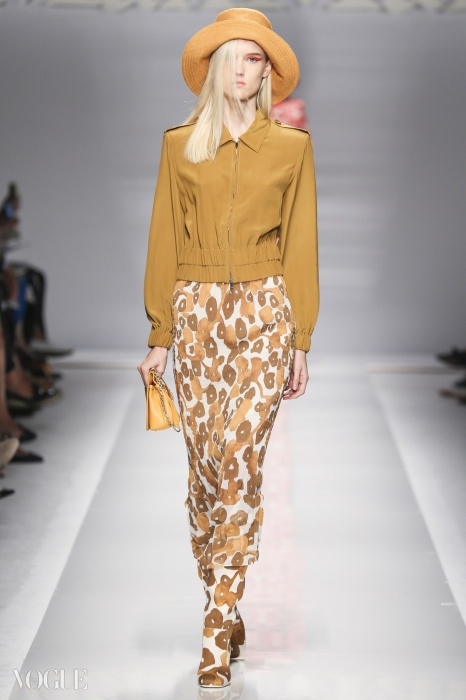
MaxMara
눈에 띄는 컬러는 머스터드였고, 부드러운 종 모양 모자가 얼굴을 감쌌으며, 플라워 프린트는 무릎 높이의 부츠까지 장식했다. 막스마라가 다시 찾은 70년대! 물론, 오리지널 콘셉트 그대로는 아니었지만. 하지만 (구찌와 같은) 다른 브랜드들처럼 밀라노의 쇼들은 히피 시대에 세련된 변화를 주었다.
막스마라는 그 시대의 컬쳐 아이콘들을 택했다. 예를 들어 ‘비토리오 데시카(Vittorio de Sica)’의 영화 <핀치 콘치니의 정원(The Garden of th Finzi Continis)>이나, 여배우 ‘안젤리카 휴스턴’의 쿨한 우아함 같은 것.
결과는? 머리부터 부츠 발끝까지 작은 꽃무늬와 손 뜨개 패치워크가 들어간 의상들이 탄생했다. 영국인인 내게 이 모든 것은 비바(Biba, 1960~70년대 런던의 아이콘적인 매장)의 낡은 버전처럼 보였다. 그러나 히피 시대에 대한 막스마라의 세련된 시각은 막스마라의 에센셜 아이템인 잘 재단된 코트들과 미디 스커트로 멋지게 연출됐다. 가벼운 패브릭을 선택해서 의상들은 훨씬 신선해 보였다.
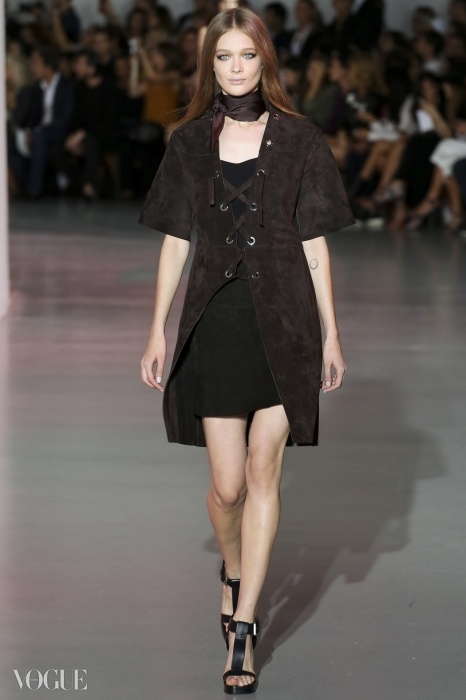
Costume National
코스튬 내셔널의 프로그램 노트를 읽으면서 나의 시선은 ‘가방’ 부분에 쏠려 있었다. 그 부분에는 이렇게 쓰여 있었다. 버닝 백, 샌프란시스코 포셰트, 산타페 메신저, 팜 스프링스 버켓 백∙∙∙ 과연 밀라노에서는 보기 드문 이 미니멀리스트 디자이너가 70년대를 살려낼 수 있을 것인가?
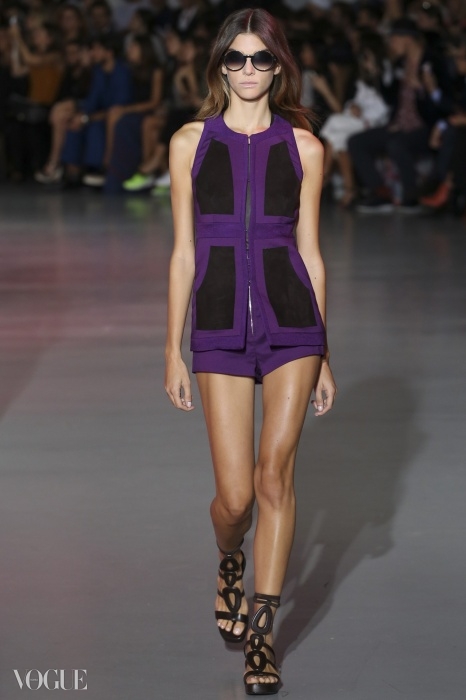
2015년 여름 패션이 히피의 흔적을 따라가야만 한다면, 코스튬 내셔널은 그것을 스타일리시한 방식으로 해석해냈다. 튜닉을 거대한 끈 장식으로 조이거나 솔기가 아일릿으로 강조됨에 따라 스웨이드는 실크만큼이나 유연하게 느껴졌다. 프린지 장식이 달린 가방들은 고급스러웠으며 결코 투박하지 않았다. 색조는 딥 퍼플, 더스티 블루, 그리고 풍성한 초콜렛 브라운으로 이루어졌다. 카파사는 자신이 1984년까지 10년간 진행되었던 스톤헨지(Stonehenge) 프리 뮤직 페스티벌의 젊은이들의 문화에서 영감을 받았다고 말했다. 이번 컬렉션은 잘 다듬어진 완성작이었다. 하지만 여전히 또 한번의 1970년대였다.
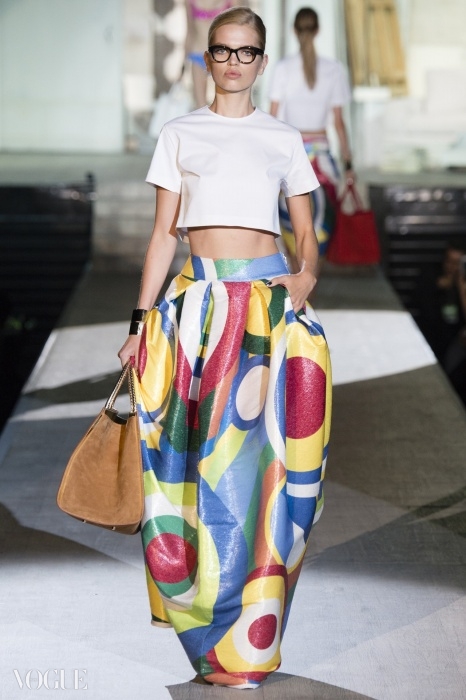
DSquared2
60년대의 상징적인 곡선형의 램프부터 시작해 다채로운 색상의 오버사이즈 의상들, 나아가 사운드트랙을 장식한 디스클로저(Disclosure)의 “When a Fire Starts to Burn”까지, 디스퀘어드가 보여주려 했던 메시지가 무엇이었든 쌍둥이 디자이너 딘과 댄 케이튼은 거대한 포부를 품고 있었다. 이번 쇼에는 밝은 색상의 가죽 패치가 등장해 그래픽 패턴, 색상 블록을 창조해내며 전반적으로 대담한 느낌을 전달했다.

이 디자인 듀오는 이브닝 의상들을 고수하는 것처럼 보였다. 어쩌면 티셔츠와 함께 매치한 커다란 크기의 환상적인 스커트는 오로지 파티만을 위한 것일 수도 있었다. 이 영리한 브랜드는 조그만 스커트와 매치한, 구김이 들어간 패턴의 바지 같은 어처구니 없는 의상들을 현명한 팬츠 수트 사이에 간간이 배치하며 현실감각을 유지했다. 스포츠와 예술과 파티가 결합된 컬렉션으로서 완벽할 정도로 훌륭했음에도 불구하고, 패션을 불타오르게 한 것은 음악뿐이었다.
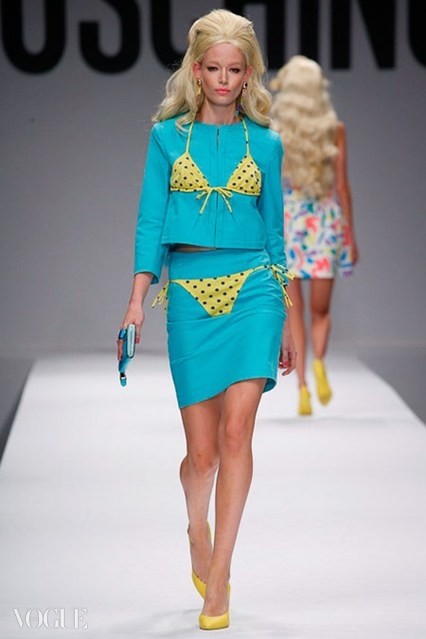
Moschino
“Barbie, Barbie, let’s go party”라는 노래가 흘러 나오면서 모델들이 거대한 금발 머리와 잔뜩 부푼 가슴을 연출한 채 핑크색의 앙증맞은 가방을 들고 (심지어는 롤러 스케이트를 타고) 런웨이를 걸어 나왔다. 바비 드레스 차림의 모델이 입은 티셔츠 위에는 “5세 이상을 위한 모스키노(Moschino for age 5 and over)”라고 쓰여 있었는데, 이 메세지는 디자이너 제레미 스콧의 의상에서도 찾아볼 수 있었다.
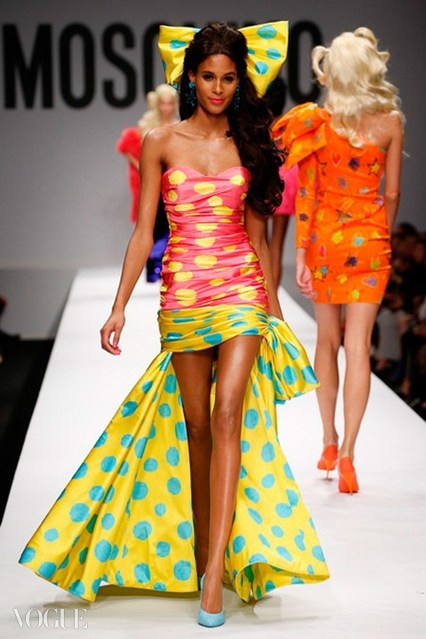
“바비는 무척 발랄해요. 저는 그 경쾌함과 재미를 패션으로 가져오고 싶었어요.” 백스테이지에서 제레미 스콧이 말했다. 미국 출신의 디자이너는 자신의 두 번째 모스키노 쇼에서 이 이탈리아 브랜드를 슈퍼 히어로의 위치로 격상시켰다. 바로 요란한 금장 가죽 미니스커트, 은색 스키니 팬츠, 흩날리는 흰색 튤, 아플리케 비키니 상하의와 매치된 의상이 양념으로 삽입된 컬렉션에 환호하는 젊은 관객들에게 말이다.

제레미 스콧은 유머와 스타일에 대하여 진정한 감각을 지니고 있다. 바비풍의 배경과 가발, 괴짜스러운 액세서리를 제거하고 나니 모스키노를 대표하는 발랄한 테일러드 수트를 발견할 수 있었다. 쇼가 벌룬 스커트로 부풀어 오르는 순간 이 쇼는 재미있는 연출에서 하나의 풍자극으로 변신했다.
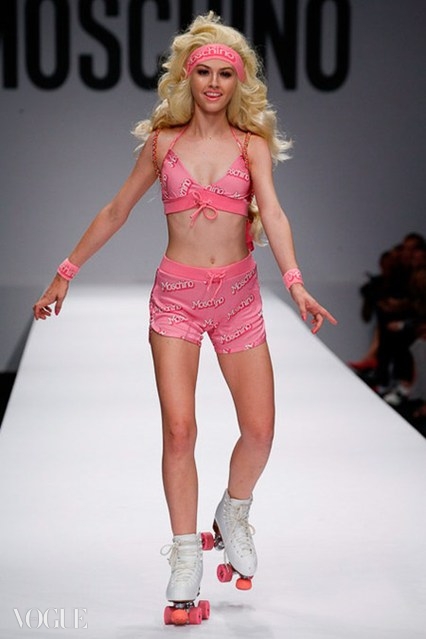
하지만 스콧이 이루어내야 하는 한 가지 과제는 여전히 남아 있다. 고인이 된 프랑코 모스키노가 반핵(anti-nuclear)운동을 상징하는 패션을 탄생시킨 것은 세계의 현실에 대한 깊은 확신에서부터 비롯된 것이었다. 물론 과거는 과거일 뿐이다. 하지만 21세기에도 제레미 스콧이 자신의 작업영역으로 끌어들일 수 있는, 예를 들면 윤리적 패션과 같은 각종 쟁점과 이슈들이 존재한다. 그리고 그렇게 하기 위해서는 먼저 바비의 머리를 염색하는 일부터 멈춰야만 할 것이다.
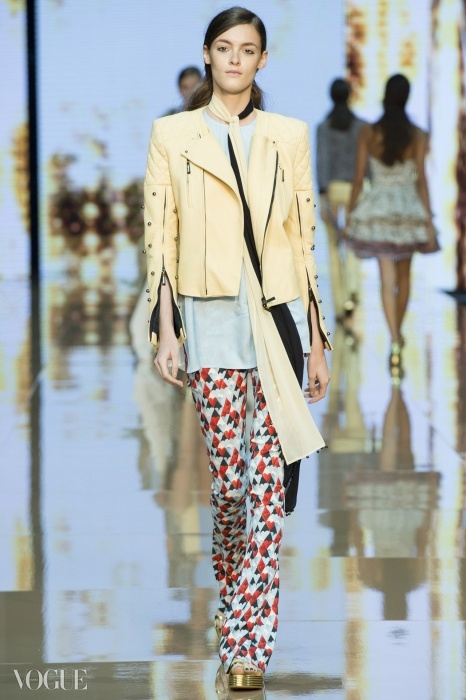
Just Cavalli
할리우드의 셀러브리티들을 끌어들이는 코첼라(Coachella) 뮤직 페스티벌이나 영국의 글래스톤베리(Glastonbury) 페스티벌이 이제는 반체제적 문화와는 거리가 멀어진 만큼, 새롭게 부활한 현재의 70년대 또한 매우 고급스러운 히피로 등장했다. 저스트 카발리 쇼는 언제나 패셔너블한 보헤미안을 추구해왔고, 하늘거리는 시폰과 물결치는 스커트가 밀라노 패션계로 돌아온 이래, 로베르토 카발리의 허리부터 넉넉하게 퍼지는 깃털처럼 가벼운 맥시 드레스, 꽃무늬 프린트, 심지어는 꽃무늬의 오버올까지도 정확하게 목표에 명중했다.
이번 쇼는 70년대가 어떻게 재해석될 수 있는지를 증명해 보였다. 칙칙한 머스터드와 흙빛 브라운 색조 대신 신선한 색조를 가지고 말이다. 저스트 카발리는 여름용 테일러드 팬츠 수트나 흰색의 영국식 자수 드레스를 더함으로써 까발리 만의 21세기 보헤미안 랩소디를 들려주었다. 새롭지는 않았지만 신선했다.
Kiton
키톤의 밀라노 본사에 들어섰을 때 나를 가장 먼저 환영해 준 것은 바로 모델들이 입고 있는 테일러드 재킷의 지중해 색과 조각가이자 화가인 밈모 팔라디노(Mimmo Paladino)의 대담한 3차원 작품들이었다. 나는 최근 방문했던 나폴리로 다시 되돌아간 느낌을 받았다. 파도가 넘실대는 해안, 대리석 조각들, 초록이 가미된 잿빛 거리, 부드럽고 편안한 나폴리 스타일의 여름 재킷을 입은 다양한 연령대의 남자들∙∙∙ 또한 남성복 재킷을 직접 손으로 제작하여 매우 정교한 결과물로 만들어내는 키톤의 장인들도 머릿속에 떠올랐다.
나의 시선은 여성복 재킷의 강렬한 색조에 사로잡혔다. 체리 핑크, 카나리아, 에메랄드, 네이비 블루, 황혼 녘의 선홍색과 나폴리 해안의 물빛보다 훨씬 더 신선해 보이는 푸른 바다의 빛깔이 그것이었다. 키톤 가의 지오바나 파오네가 캐시미어, 실크, 리넨이 조합된 그 부드러운 원단을 내가 직접 만져볼 수 있게 해주기를. 하지만 의상의 형태로 인해 나의 열정은 곧 사그라졌다. 핏은 완벽했다. 물론 세상에는 완벽하게 재단된 재킷을 입고 회의실에 입장하기를 원하는 금융계 여성들도 존재한다. 하지만 기술과 테일러링에 있어 탁월함을 자랑하는 키톤이라면 나폴리 남성들의 그 헐렁하고 자연스러우면서도 매력적인 수트를 다시 한번 주의 깊게 들여다 봐야 할 것이다. 그리고 그것을 여성의 몸 형태에 맞게 변모시켜야 할 것이다.
English Ver.
Milan Fashion Week Day One BY SUZY MENKES
Suzy Menkes reports from the Alberta Ferretti, Gucci, Fausto Puglisi, Stella Jean and Angelos Bratis shows at Milan Fashion Week.
Bratis: Grecian purism for the 21st century
“It’s not just him – it also helps us. It is refreshing to see what other people are doing,” said Giorgio Armani, working on his new collection, while on stage Angelos Bratis, an award-winning Italian designer of Greek origin, showed his summer 2015 collection.
It was a promising start for the Milan season, where the sweet bird of youth is trying to find a voice.
Angelos Bratis opened his show as he meant to continue: with dresses shaped and draped with apparent ease – but actually with great skill. He turned Grecian folds into 21st-century clothes, adding blocks of bright colour to break into the curves.
“I’m not a minimalist – I am a purist,” said Bratis backstage, showing on his mood board the work of Greek artist Yiannis Moralis, with its sensual, even sexual, forms.
Bratis took the sensual side, draping dresses but often breaking up the waterfall of fabric with panels of subtle colour, such as stormy sea blue with grey and light tan. For a brief moment there was a dot of pattern.
He also displayed bold jewellery by Maria Mastori, the shapes snaking around the neck or creating an amulet.
The Bratis short, draped dresses seemed even more convincing than the long, which, with a dropped arm hole, looked a bit too much like Clytemnestra on the operatic stage.
But this was a fine show, setting a new mood of elegant ease in Milan. And Angelo Bratis showed his appreciation for Armani hosting the event by waving a sign with the words: “Thank you, Giorgio”.
Gucci: A New Crop of Denim
Was it the presence of Charlotte Casiraghi, Gucci's equestrian ambassador, sitting front row with a snakeskin-covered Kate Moss, which made the show on the opening day of the Milan season seem rather frisky?
“Crazy Girl” went the soundtrack, while out came the models in suede outfits with a hint of the Seventies, and then denim, partnering with Glitter Gulch sparkles and patchworks of hairy furs from fox to goat.
“And Asia!” said designer Frida Giannini backstage, pointing to the flowers patterning her silk top. Perhaps that was a nod to the presence of Chinese actress Yang Mi in the audience, or to François-Henri Pinault, who heads Gucci's luxury group and who explained how strategy for high-end sales in China cannot follow the same path as in America and Europe.
Although there were a few dull passages in Gucci’s spring/summer 2015 collection, when the show seemed focused on product, it was mostly well mixed. Simpler tailored blouses dosed down the hippie-de-luxe glamour and the cute dresses printed with Chinese flowers or Japanese cranes that melded seamlessly into eveningwear. There was none of Frida's favourite and familiar black. The after-dark clothes were therefore less red carpet and more real world.
What seemed fresh this season was the casual luxury that should be the essence of Gucci. And also the brand’s heartland: accessories. There were belts circling twice around the waist, tough Seventies-style bags and, on the cropped denim culottes, gold naval buttons, strategically placed just below the navel.
Embellishment did not end with the buttons. There were also recurring examples of military frogging, which gave a hard edge to glamour.
A significant fashion story was colour – the Seventies’ bordeaux, rust and orange that switched later to blue and green. The way the colours were shaded, especially for the fur, was subtle.
The one mystery is why Gucci, which launched a beauty line this season and was responsible for the luscious lips of Charlotte Casiraghi, does not put more focus on one of its existing and iconic products: shoes. There were ginger suede boots, orange bootees and green sandals with thick heels, but nothing approaching the instantly recognisable bar-and-bit shoes that were the origin of Gucci’s fame.
Stella Jean
With oversized sporty T-shirts, blouses patterned with foliage and skirts printed with an image of a hut dominated by palm trees, Stella Jean went on a different destination for her new collection.
“I went home,” she said, meaning that for the first time in her career as a designer she looked at Haïti, part of her family blood line. And it was not just as background to colourful pictorial patterns, printed even on swimsuits.
Part of her mission was to have things made in Haïti, using the expertise of the United Nations’ International Trade Centre (ITC) Ethical Fashion Initiative, which lobbies for ethical and fair trade manufacturing centres in developing countries.
So as much as the designer, who was raised in Italy, wanted to capture the country through its Art Naïf, she was also determined to help its people.
The recurring pattern of donkeys and “tap tap” painted buses were inspired by Haïti but were produced on modern skirts, full or narrow. They showed that Stella Jean had moved her fashion work forward.
But Stella Jean also had artisanal jewellery – horn bracelets, wrought-iron metalwork and even decoration in papier-mâché.
Simone Cipriani, who heads the ITC project, said at the show that plans are moving fast forward, and a dedicated factory is being built in Ghana. As the Stella Jean show proved, you can rejoice and be joyous while empowering hand-workers.
Fausto Puglisi
If Julius Caesar had gone clubbing, he would surely have looked like this: gladiator sandals stomping over an illuminated checkerboard floor.
Then robes in more checks, like mosaics from Herculaneum. And a sense of orderly geometry at every turn.
The collection that Fausto Puglisi sent out to the blasting music of Daft Punk was graphic, dramatic and to the point.
The designer, after working in Hollywood, has a cinematic vision of fashion. Each garment – perhaps a skirt as stiff as a cornet flaring out at the hem, or a tailored piece doused in sharp colours of orange and lime – seemed like part of a modernist movie set.
The designer even cited the idea of “Star Wars meets Barbarella” and a tribute to Stanley Kubrick’s 2001: A Space Odyssey. He also referred to the fashion maestros of the Sixties: André Courrèges and Rudi Gernreich.
But the intriguing thing about Fausto is that for all his references – going right back to ancient Rome – his designs look rigorously contemporary.
The geometric patterns and iridescent surfaces could surely be created only on computer and in a digitalised world. Although he has been compared to a young Gianni Versace, that designer too was pre-digital.
Fausto may willingly admit his references. But the result is resolutely and explosively contemporary.
Ferretti's fairy-like fragility
Alberta Ferretti is a princess of fashion fragility. The delicacy of her work for spring/summer 2015 included nude chiffon with pleats so tiny they looked as though they had come from the fingers of fairies.
Flowers came in bowers, the petals spreading over a dress. Even denim in her hands looked as soft as silk.
But the intriguing thing about the Ferretti show is that red-carpet glamour had been exchanged for a delicate kind of casual. New looks from the designer included airy chiffon trousers, or there was cowboy fringing, as seen in the Seventies.
What had melted away was anything body conscious or curvy.
Alberta Ferretti does not have a vulgar bone in her body, so her red-carpet looks in the past were always gentle and tasteful. But just the idea of using denim and treating it with cut-work showed a new kind of sporty casualness. The flowers formed a secret garden on the bodice, with nothing lush or sensual.
It is important for designers to move forward and Ferretti did that gracefully. Now let's dream that the A-listers follow her lead and take a gentler approach to dressing up.
Fay: Streetwise and oversize
Turning streetwear into fashion is nothing new. It has been a staple of 21st-century style to make oversize tops, graphic slogans and geometric lines into sporty clothes.
So the re-branding of Fay, the outerwear and casual brand from the Tod’s empire, saw a sportswear dynamic with the tag "Fay Time" on tank tops, sweater seams or giant backpacks. Any space left was made over to images of Lucy, the cartoon character from Charles Schulz's Peanuts.
The once aggressive connection with this rapper look was further sanitised by the use of pale pink and an overall feeling of youthful fun, rather than rebellion.
Designers Tommaso Aquilano and Roberto Rimondi, better known for their rich fabrics and historical vision, were on a mission to connect Fay to the wired world. They used techno fabrics, seamlessly connected to Italy’s luxurious and elegant manufacturing.
But the stand-out pieces from this company built on footwear were the basketball shoes, feminised with a heel and a strap to make them a cute accessory for a Milanese schoolgirl or her global equivalent.
Milan Fashion Week Day Two BY SUZY MENKES
Suzy Menkes reports from the Moschino, Prada, Costume National, Just Cavalli, Fendi, Emporio Armani, MaxMara and Kiton shows at Milan Fashion Week.
Fendi: An orchestra of orchids
Fendi is hot and for the new Milan show it went up to boiling point.
Guests were greeted by a long runway with Coliseum-style arched windows, as interpreted in the Mussolini-era building that is Fendi's new headquarters in Rome.
Then there were the sparky accessories, like Silvia Venturini Fendi's glamorous, be-jewelled “Tres baguette” bag; or that little, furry, sold-out-in-a-second “Karlito” (for “little Karl”) bag charm. That was swung by top model Cara Delevingne, who opened the show in a cute, short, orchid-print dress.
The orchid is a new Fendi “logo”, worn by Lagerfeld himself as a necktie jewel. It was translated into handbag decorations and also appeared at the nape of each model’s hairstyle.
Thinking back to the poetry of last season, when Karl buried fresh flowers in Fendi furs, I could see the logic of the floral branding. But the new spring/summer 2015 show was in no way romantic – unless you counted pale blue and pink as the colours for long chiffon skirts.
Most of the collection was hard and strong: short dresses where straight lines were drawn into graphic decoration or bodices that were sliced like strip curtains at a car wash. The shoes had similar straps but they were more delicate.
Denim was included in Lagerfeld's tough geometry, which was drawn with a compass for weird, jodhpur-shaped jeans.
I surmised that Karl had been influenced by the new Fendi HQ, Palazzo della Civiltà Italiana in Rome, which he had photographed so graphically in the Fendi programme.
The bag accessories have been a luxury super-hit, as evidenced by Marigay McKee, new President of Saks Fifth Avenue, rushing to beg for first dibs from Pietro Beccari, Fendi Chairman and CEO, who has done so much to revitalise the brand.
I asked Pietro if the orchid will stay as part of the Fendi branding.
“For at least the next two seasons,” he replied. “But you know Karl…”
Max Mara: Rebranding the Seventies
Mustard was the colour, soft cloche hats framed the face and floral patterns ran right down to knee-high boots.
MaxMara revisited the Seventies – not an original concept – but like other brands, namely Gucci, the Milan shows are giving the hippie years a sophisticated makeover.
MaxMara chose cultural icons from that period, like Vittorio de Sica's film, The Garden of the Finzi Continis, or the angular elegance of the actress Anjelica Huston. The result? Outfits head to booted toe in a small floral pattern and the occasional crochet patchwork.
Being British, it all looked to me like a scrubbed-up version of Biba. But this gentrified vision of the hippie years was nicely done with its well-cut coats – MaxMara's heartland – and mid-calf skirts. The lightness of the fabrics made them look fresh.
Why Matteo Renzi should be Milan's Fashion Role Model
There is a favourite line from rockers, hippies and love children about their misspent, drug-filled, manic youth: “If you can remember the Seventies, you weren’t there!”
One person who can honestly say he was not present is Matteo Renzi, Italy’s youthful new Prime Minister. Now just 39, he was born in 1975, well after the Age of Aquarius and the Summer of Love back in 1967.
In the Seventies, he was barely in his cradle. So with this dynamic role model of the youngest leader in Europe and beyond, why would designers at Milan Fashion Week appear to be mad about the Seventies?
The colours of that decade are everywhere: mustard, apricot, mud brown and burgundy. There are suede tunics – or suede anything. There are dangling fringes galore. And even – Oh horror! – variations on flared trousers.
At Gucci, designer Frida Giannini was half in love with the era, recreating it in a luxurious, streamlined Gucci way.
Alberta Ferretti's love children wore fringed suede and some flowery dresses.
MaxMara went mad for the moment when floppy hats and high-rise boots were in vogue. Then they were shown with matching clothes – in the same print.
Even at Costume National, designer Ennio Capasa went for suede and fringe.
Of course, modern suede and laser-cutting give a more 20th-century look to the old hefty hide. And digital patterns give a new meaning to Flower Power.
But surely it is time that Italian designers looked forward – not back – however witty and stylish some of these pastiches can be?
For Prime Minister Renzi, with his penchant for taking off his jacket and appearing in a sharp shirt, has the right fashion idea. Shirts are hot. Or rather, they are cool. And they are much more suited than suede and fringe to modern times.
Prada: Updating Antiquity
Somewhere on the far side of an undulating sand dune, where the sound of the sea issued from beyond the plush gold carpet, Miuccia Prada staged her confrontation between the beauty of antiquity and the present’s demand for simplicity.
On the one side, intense brocade pieces that looked as though they had been found in an old attic, their beauty and handwork still more or less intact, except for the fronds of unravelling threads.
On the other side of this struggle between sense and sensibility were severe coats and dresses, their plain shapes traced and retraced with overstitching. They seemed like a fashion version of Arte Povera, while the brocades suggested 19th-century grandeur.
Take Prada’s water or the wine. And you get the same socks with a band of flowers at the calf and a stout-heeled shoe.
But as ever with Prada – and this show was comprehensively Miuccia in spirit – nothing is as it seems.
“It is the irresistible work of artisans, like making chandeliers,” said Prada backstage, explaining how she had set the best Italian craftspeople to re-work and re-interpret the antique brocades.
Prada’s wrestling to align opposites has been one of her ongoing challenges of the last two decades. The roar of excitement and applause, as she took a surprisingly generous bow, showed how much people respect her and admire her fashion courage.
What was different about this collection was its historic beauty. No more of the ugly aesthetic, yet neither a nostalgia for times past. No more male/female conflicts, for all the clothes were feminine, with no trousers, just a decorative brocade skirt with a simple sweater.
Instead, Miuccia followed her delirious desire to preserve the skills of the past but always and forever remain relevant.
인스타그램 @suzymenkesvogue
트위터 @SuzyMenkesVogue
페이스북 facebook.com/suzymenkes
- 에디터
- 보그 인터내셔널 에디터 / 수지 멘키스(Suzy Menkes)
- 포토그래퍼
- InDigital
추천기사
-

패션 화보
손에서 놓을 수 없는 것
2025.04.21by 유정수
-

셀러브리티 스타일
2025년 셀럽들의 베스트 코첼라 룩!
2025.04.21by 황혜원, Christian Allaire
-

패션 아이템
올해는 미우치아 프라다처럼 샌들에 양말 신기!
2025.04.17by 하솔휘, Paulina Berges
-

아트
패러디와 유머의 예술, 샘바이펜
2025.04.15by 권민지
-

Beauty
로라 메르시에, 채수빈과 선보이는 우아한 스프링 메이크업 ‘로지블룸룩’
2025.04.11by 서명희
-

패션 아이템
2025년에도 헐렁한 청바지가 살아남은 이유
2025.04.15by 하솔휘, Lucrezia Malavolta
인기기사
지금 인기 있는 뷰티 기사
PEOPLE NOW
지금, 보그가 주목하는 인물


